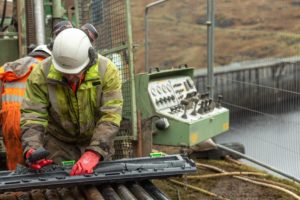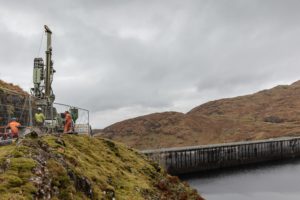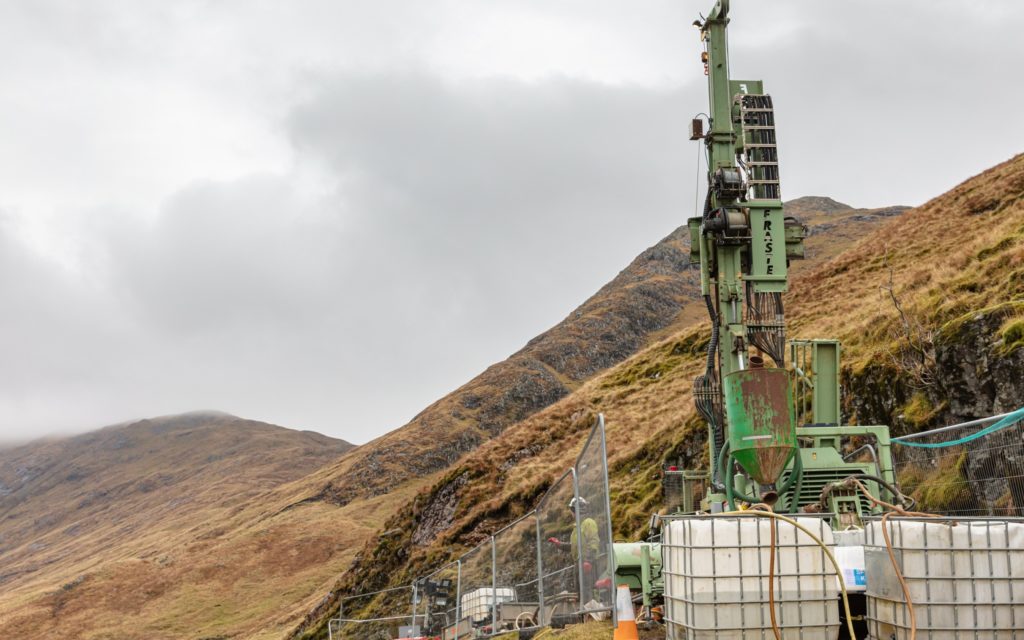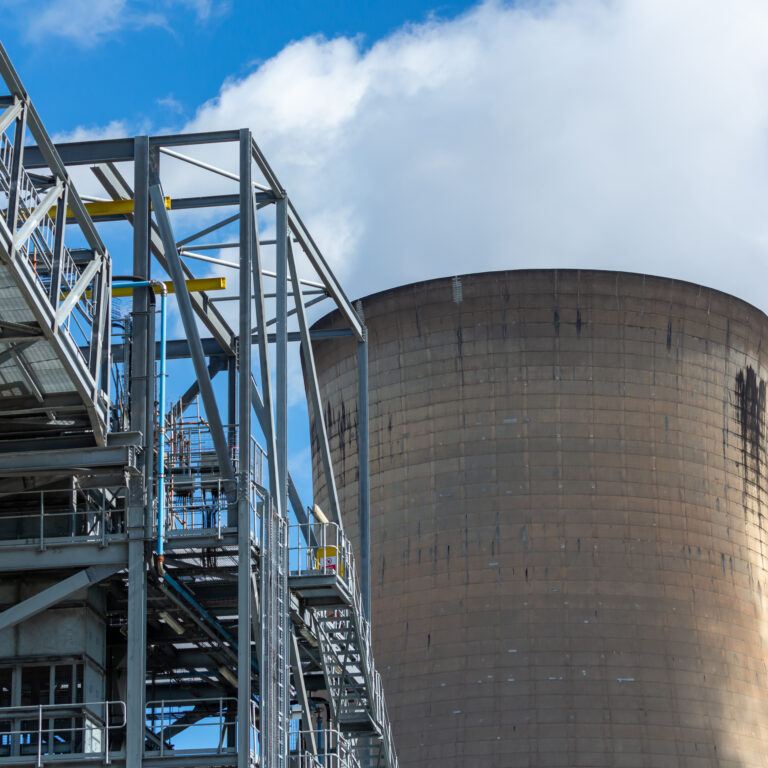Exploratory ground investigations are now underway at its existing Cruachan facility in Scotland, where the company plans to build a new 600 MW underground plant. A 70m deep borehole is being drilled to recover rock core which will be analysed in a lab to determine structural and geological stability for elements of the new plant.
The preliminary works are being carried out whilst the project awaits consent from the Scottish Government alongside an updated policy and market support mechanism from the UK Government.

A worker inspects rock core samples scaled
Increasing the UK’s pumped storage hydro capacity is critical to enabling more renewable power to come online, strengthening the country’s energy security whilst helping Britain decarbonise.
Ian Kinnaird, Drax’s Scottish Assets Director, said:
“This is a significant moment in the expansion of Cruachan. The project team has been working extremely hard to move the development forward, and the start of ground investigation works is the next phase in delivering this vitally important new plant.
“The scale of the proposed development matches Drax’s ambitions when it comes to tackling the climate crisis. More than 2 million tonnes of rock will be excavated to create a new cavern inside the mountain which will be big enough to house Big Ben on its side.
“Expanding Cruachan will strengthen the UK’s energy security by enabling more homegrown renewable electricity to come online to power homes and businesses across the country. This major infrastructure project will support hundreds of jobs and provide a real boost to the Scottish economy.”
The new underground 600 MW plant would be one of the largest infrastructure projects carried out in Scotland for many years, with Drax expecting the plant to come online in 2030 following a six-year period of construction and an investment of around £500m.

The works are a major step forward for the development
Pumped storage hydro plants act like giant water batteries, using reversible turbines to pump water from a lower reservoir to an upper reservoir which stores excess power from wind farms and other low carbon technologies when supply outstrips demand. These same turbines are then reversed to bring the stored water back through the plant to generate power when it is needed.
In order to deploy this critical technology, Drax must secure consent from the Scottish Government alongside an updated policy and market support mechanism from the UK Government.
The existing lack of an appropriate framework for new long-duration, large-scale electricity storage technologies means that private investment cannot currently be secured in new pumped storage hydro projects, with no new plants built anywhere in the UK since 1984 despite their critical role in decarbonisation.
ENDS
Picture captions:
Top image caption: A 70m-deep bore hole is being drilled at the site
Media contacts:
Aidan Kerr
Media Manager
E: aidan.kerr@drax.com
T: 07849090368
Ali Lewis
Head of Media & PR
E: Ali.Lewis@Drax.com
T: 07712 670 888
Editor’s Notes
- Drax applied for development consent from the Scottish Government under Section 36 of the Electricity Act 1989 in May 2022.
- We expect a response to the application to be received in Q2 2023.
- BEIS has pledged to introduce a new policy and market support framework to enable private investment in large-scale, long-duration storage projects by 2024.
- No investment decision has yet been taken by Drax and development remains subject to both development consent and an appropriate regulatory framework.
About Drax
Drax Group’s purpose is to enable a zero carbon, lower cost energy future and in 2019 announced a world-leading ambition to be carbon negative by 2030, using bioenergy with carbon capture and storage (BECCS) technology.
Drax’s around 3,000 employees operate across three principal areas of activity – electricity generation, electricity sales to business customers and compressed wood pellet production and supply to third parties. For more information visit www.drax.com
Power generation:
Drax owns and operates a portfolio of renewable electricity generation assets in England and Scotland. The assets include the UK’s largest power station, based at Selby, North Yorkshire, which supplies five percent of the country’s electricity needs.
Having converted Drax Power Station to use sustainable biomass instead of coal it has become the UK’s biggest renewable power generator and the largest decarbonisation project in Europe. It is also where Drax is piloting the groundbreaking negative emissions technology BECCS within its CCUS (Carbon Capture Utilisation and Storage) Incubation Area.
Its pumped storage, hydro and energy from waste assets in Scotland include Cruachan Power Station – a flexible pumped storage facility within the hollowed-out mountain Ben Cruachan.
The Group also aims to build on its BECCS innovation at Drax Power Station with a target to deliver 4 million tonnes of negative CO2 emissions each year from new-build BECCS outside of the UK by 2030 and is currently developing models for North American and European markets.
Pellet production and supply:
The Group has 17 operational pellet plants and developments with nameplate production capacity of around 5 million tonnes a year.
Drax is targeting 8 million tonnes of production capacity by 2030, which will require the development of over 3 million tonnes of new biomass pellet production capacity. The pellets are produced using materials sourced from sustainably managed working forests and are supplied to third party customers in Europe and Asia for the generation of renewable power.
Drax’s pellet plants supply biomass used at its own power station in North Yorkshire, England to generate flexible, renewable power for the UK’s homes and businesses, and also to customers in Europe and Asia.
Customers:
Drax supplies renewable electricity to UK businesses, offering a range of energy-related services including energy optimisation, as well as electric vehicle strategy and management.
To find out more go to the website www.energy.drax.com



















